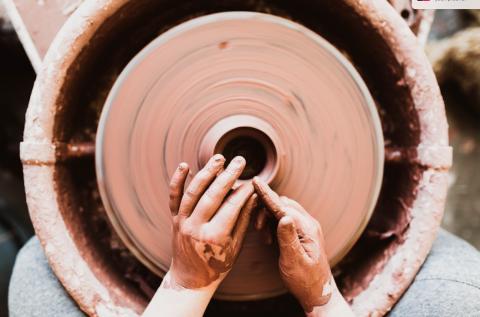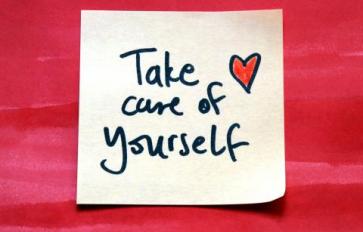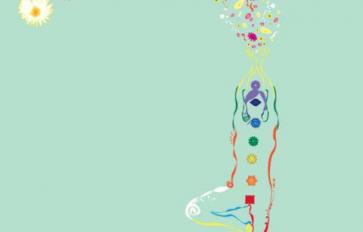
“Aparigraha...the sanskrit word for non-attachment,” the yoga instructor began as she moved across the mat-bejeweled floor. “Refers to an attitude of non-clinging. It’s natural for us as humans to try to cling to things that we think will make us happy.” She went on to describe what it looked like in a physical sense – clinging to a job, a car, a trip we had planned.
“But the practice of aparigraha is just as important for the intangible things we cling to as well.” She was encouraging us to let go of any expectations we might be clinging to of how our headstand would feel in a few minutes, and to just let ourselves be in that pose however we were that day.
“It’s easy to cling to the idea we have of how things should be, but that often gets in the way of enjoying things the way they are,” she continued.
As some of us swayed and toppled and others settled perfectly still, the instructor went about an aparigraha in a material fashion. To challenge her sense of non-attachment, she was donating as many items as the calendar date for the whole month -- one on the first, two on the second, and so on. It was a physical symbol of what she was cuing us to practice internally.
The idea is not to own as few belongings as possible or reach any sort of monk-like existence, but to practice non-attachment from outcomes, images, or things as part of our self-identity. Refusing to attach to a certain idea or image we have in our heads of how things are supposed to be (even of just the perfect headstand) allows us to judge less, and invites things to be what they are intended to be. It was a beautiful concept, but after that class I left the idea there on my yoga mat for a very long time. Until a few months later when I had my attachment to outcomes seriously challenged. By dirt.
⃟
I was covered in it. I sat in a pottery class, in front of the wheel. Muddy clay dripped all over my shoes, smeared my sleeves, and splashed the floor, but that was hardly my issue.
I was making a noodle bowl. A perfectly round, scooping, big-enough-for-a-whole-packet-of-Ramen noodle bowl. But I huffed and groaned, because currently I had a loopy ashtray. It had been weeks of wedging and pulling and coning and squishing and splattering wet clay on the floor. I was so ready for something to turn out the way it was supposed to be; the way I saw it in my head.
This is how it was going: my small mugs looked more like sad pencil holders, my large mugs could only function as small espresso cups, and all other noodle bowl attempts were indistinguishable as anything other than modern art.
I scraped my sweaty hair off my forehead with the crook of my elbow, foolishly thinking it was cleaner than my muddy hands, but felt a cold wet smear across my forehead. Nice.
My eyebrows crinkled, smeared with clay and disgust, as I hunched over Noodle Bowl #4. The teacher casually strolled over with a sympathetic half-smile and perched on a stool at the empty wheel beside me.
“What are you trying to do?” she asked. I explained about the noodle bowl.
“Maybe there isn’t a noodle bowl in there,” she started. Her short red hair curled delicately at her ears and she smelled like some sort of essential oil. “Do what you know how to do, but don’t force it. Be gentle. Start where you can and go where it takes you.”
Stifling an eye roll, I nodded and stood up to start over with some new clay.
I was making a noodle bowl, damnit. That just frustrated me more. I couldn’t make anything at all if I didn’t know where I was going with it. I sat back down at my wheel with another lump of aggressively-wedged clay. I shoved and pulled and forced the clay into another Franken-bowl with shallow sides, abnormally thick bases, and uneven edges.
I sighed. The teacher peered up at me briefly from across the studio. My bowl wasn’t happening today. Fine. I’d let the lump of dirt be in charge this round.
I centered the clay, coned up, settled it back down, and pressed a little tunnel into the center of it. I dipped my hands in my plastic butter container filled with water and held them above my spinning slab. Cloudy water dripped off my fingertips onto the clay as I stared at it. I filled my lungs up with air and let it out slowly. Dispelling the visions of Ramen noodles dancing in my head, I nudged the opening of the vessel just a teensy bit wider with my thumbs.
I picked up my tiny round sponge and placed it gently at the base of my spinning puck of mud. The clay reached up and bubbled outwards. I liked it. I touched two fingers to the inside of the vessel and encouraged the curve of the walls a bit more. And then a little bit more. I began to work with the neat little mug my clay was becoming. Smoothing the lip into a rounded edge, I slowed the wheel to a stop. I removed my hands. Whoa.
The relief I felt after detaching myself from that damn noodle bowl was a result of true aparigraha. I let go of my need for control and my vision of how it should turn out, which altered my result. But more meaningful than my cute creation was the peace that came with surrendering my need to force my way.
Finally faced with a situation I couldn’t control, I was free to embrace non-attachment. No matter how hard I tried, I was not making a noodle bowl that day. Sometimes, no matter how hard we try, we don’t get the dream job we interview for. No matter how hard we try, friendships fade. But without my trying, friendships grow, doors open to new opportunities, and growth can happen inside of us. Aparigraha is allowing these things to happen at their own pace, and knowing you’ll be okay.
I smiled down at my little mug as I placed it on the shelf to dry beside my Franken-bowls. We won’t always end up with the noodle bowl we’re envisioning, but the mug that comes instead is filled with the peace we needed all along.
“Detachment is not that you should own nothing, but that nothing should own you.” -Ali Ibn Ali Talib








